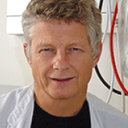Self-reported fatigue common among optimally treated HIV patients: no correlation with cerebral FDG-PET scanning abnormalities.
Parole chiave
Astratto
OBJECTIVE
It was the aim of this study to determine the prevalence and severity of fatigue among optimally treated HIV patients and to investigate the potential association with systemic inflammation and abnormalities of the distribution of cerebral glucose metabolism.
METHODS
A cohort of HIV patients (n = 95), known to be HIV positive for 5 years, on anti-retroviral therapy for a minimum of 3 years and with CD4 counts above 0.2 x 10(9) cells/l, completed a validated fatigue inventory, and plasma was analysed for pro-inflammatory markers including tumour necrosis factor-alpha, interleukin 6 and soluble urokinase receptor (suPAR) levels. The distribution of the regional cerebral metabolic rate of glucose was measured in a sub-group of patients suffering from severe fatigue (n = 9) and a group with no fatigue (n = 7) using fluorine-18-fluorodeoxyglucose positron emission tomography (FDG-PET) scanning.
RESULTS
Fifteen percent suffered from severe fatigue, but no association with pro-inflammatory markers was found. About 50% of the FDG-PET-scanned patients showed minor abnormalities in the relative cerebral metabolic rate of glucose. These abnormalities were not associated with fatigue but tended to correlate with a short HIV history (p = 0.058), a low CD4 nadir (p = 0.082) and elevated tumour necrosis factor-alpha levels (p = 0.074).
CONCLUSIONS
Fatigue is common among optimally treated HIV patients. FDG-PET-described signs of imminent neurodegeneration among HIV patients who had a low CD4 nadir may illustrate an aspect of HIV neuropathogenicity.




